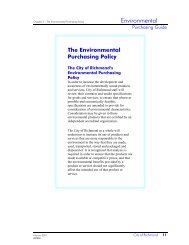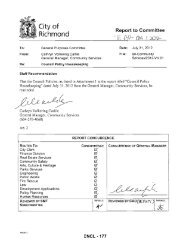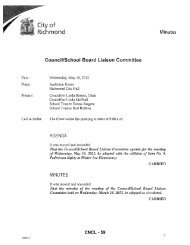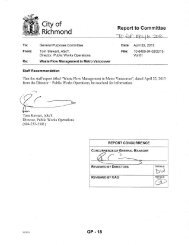steveston sanitary sewer rehabilitation by the ... - City of Richmond
steveston sanitary sewer rehabilitation by the ... - City of Richmond
steveston sanitary sewer rehabilitation by the ... - City of Richmond
Create successful ePaper yourself
Turn your PDF publications into a flip-book with our unique Google optimized e-Paper software.
February 7, 2000 - 2 -<br />
STAFF REPORT<br />
ORIGIN<br />
In recent years, Engineering staff have been inspecting <strong>the</strong> condition <strong>of</strong> <strong>the</strong> <strong>City</strong>’s existing<br />
<strong>sanitary</strong> <strong>sewer</strong> pipes using Closed Circuit Television (CCTV) to view <strong>the</strong> interiors <strong>of</strong> <strong>the</strong> <strong>sewer</strong>s.<br />
The inspection reveals that <strong>sewer</strong>s in <strong>the</strong> Steveston area are in poor condition, but repair <strong>of</strong><br />
many <strong>of</strong> <strong>the</strong>se <strong>sewer</strong>s may be expensive and difficult because <strong>the</strong>y are located in <strong>the</strong> rear <strong>of</strong><br />
developed lots. Accordingly, staff are considering undertaking <strong>the</strong>se repairs using alternative<br />
strategies o<strong>the</strong>r than conventional open cut repair. In order to solicit proposals for alternative<br />
strategies from private industry experts, staff propose to undertake <strong>the</strong> Steveston <strong>sanitary</strong> <strong>sewer</strong><br />
<strong>rehabilitation</strong> project <strong>by</strong> <strong>the</strong> Design/Build approach.<br />
ANALYSIS<br />
Conventional open cut construction for <strong>sanitary</strong> <strong>sewer</strong> <strong>rehabilitation</strong> may prove very expensive<br />
or disruptive to residents in <strong>the</strong> Steveston area because many <strong>of</strong> <strong>the</strong> <strong>sewer</strong> pipes may be in <strong>the</strong><br />
rear <strong>of</strong> landscaped yards or under high water table. A strategy combining open cut, different<br />
<strong>sewer</strong> alignments, and/or alternative technologies for <strong>sewer</strong> construction may prove more cost<br />
effective and less disruptive than open cut <strong>sewer</strong> repairs alone. The alternative technologies<br />
may include several trenchless technologies including pipe bursting, directional drilling,<br />
micro-tunnelling, horizontal auger boring or <strong>sewer</strong> re-lining.<br />
The traditional administrative approach to public works construction is to prepare an engineered<br />
design, and <strong>the</strong>n to commission a construction crew, ei<strong>the</strong>r a <strong>City</strong> crew or a contracted crew, to<br />
undertake construction based on <strong>the</strong> design. An alternative approach for project procurement is<br />
<strong>the</strong> Design/Build approach.<br />
The Design/Build Approach<br />
The Design/Build approach is an alternative procurement process for design and construction<br />
services. Instead <strong>of</strong> <strong>the</strong> traditional process where design engineers prepare contract<br />
documents and drawings for tender, <strong>the</strong> Design/Build approach solicits detailed proposals from<br />
pre-qualified proponent teams comprising designers and contractors to deliver a complete<br />
design and construction solution for <strong>the</strong> project. The shortlist <strong>of</strong> pre-qualified proponent teams<br />
(usually three teams) is selected, based on submission and evaluation <strong>of</strong> <strong>the</strong>ir credentials in<br />
response to a Request For Expressions <strong>of</strong> Interest (RFEI).<br />
The pre-qualified proponent teams are provided with a Request for Proposal (RFP) <strong>by</strong> <strong>the</strong><br />
Owner, <strong>the</strong> <strong>City</strong> <strong>of</strong> <strong>Richmond</strong>. The RFP outlines <strong>the</strong> scope <strong>of</strong> <strong>the</strong> project, <strong>the</strong> criteria to be used<br />
in selection <strong>of</strong> <strong>the</strong> successful proponent, <strong>the</strong> performance specifications required <strong>of</strong> <strong>the</strong><br />
proponent in undertaking <strong>the</strong> project, and <strong>the</strong> form <strong>of</strong> agreement under which <strong>the</strong> project will<br />
proceed.<br />
It is expected that <strong>the</strong> Design/Build approach will result in a project providing equal or better<br />
performance, at equal or lower cost, in equal or less time because combining designers and<br />
builders on a single proponent team motivates <strong>the</strong>m to collaborate. Innovative designs which<br />
are also practical and cost-effective to build are <strong>the</strong> expected results. To realise <strong>the</strong> potential<br />
benefits <strong>of</strong> Design/Build, projects with high opportunity for innovation and alternatives should be<br />
selected.<br />
135000 /
















